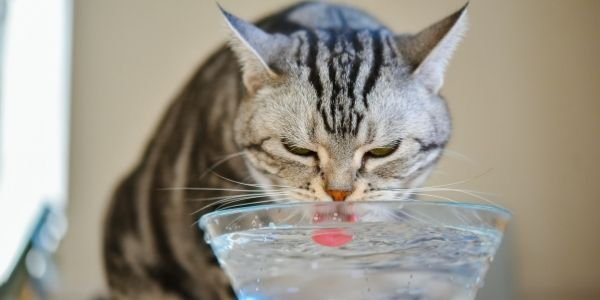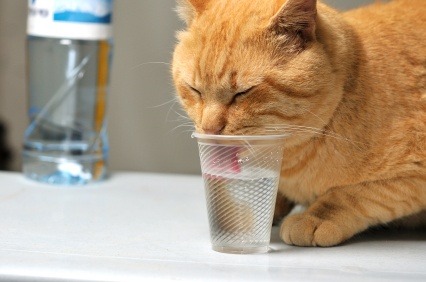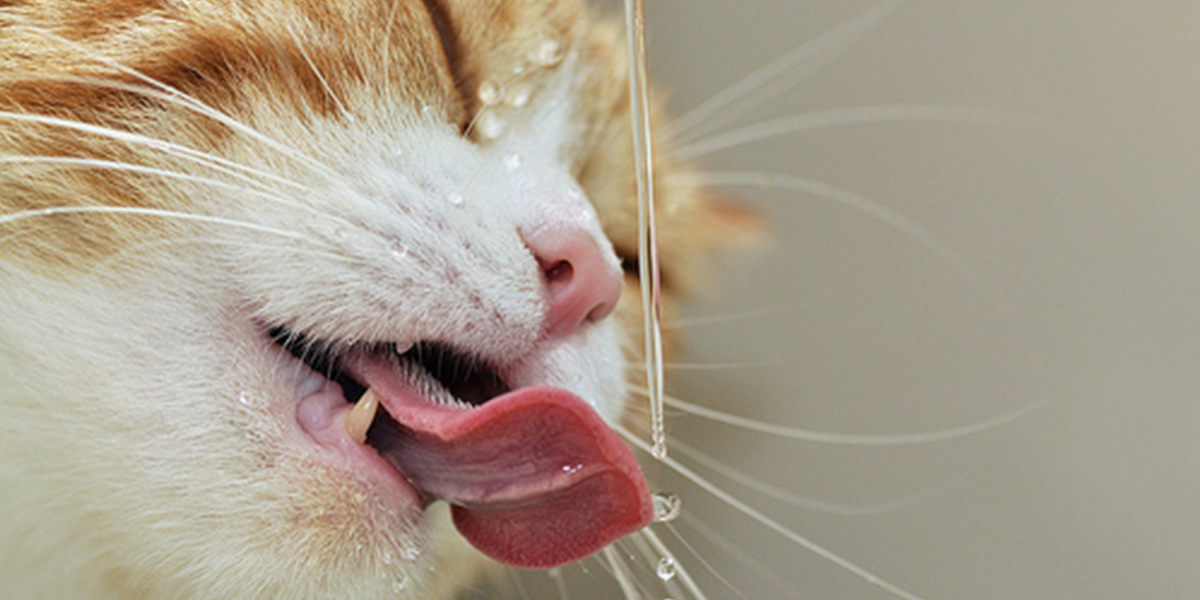
We’re all cat lovers. We also enjoy keeping a few houseplants nearby. Therefore, if your cat accidentally drinks water from the saucer of your houseplant, it could be an issue.
If they are thirsty, cats will drink from a plant saucer. However, cats may be in risk if they consume the soil and nutrients used to cultivate plants. In addition, the soil may include infections, parasites, and hazardous organic waste that could harm your cat.
When an ailment first appears, it is important to take it seriously and take the cat to the doctor for more testing.
In this essay, I’ll go over what you can do to stop such behavior as well as the warning signs your cat may be ingesting plant drainage water.
Table of Contents
Will a Cat Get Sick If It Drinks Plant Drainage Water or Stagnant Water?

It seems as though there might be nothing wrong with cats consuming liquids from still areas such as plant saucers or stagnant ponds.
But it’s possible that’s not always the case. Contaminants in the soil may find their way into plant saucers. Additionally, potting soil frequently contains fertilizers, which may be dangerous.
Any of these elements from a puddle or a plant saucer, including fertilizers, parasites, and bacteria, can make your cat ill if consumed.
It’s possible that this isn’t always the case. You might be entirely safe using your plant saucer. However, there is still a chance, so you should make an effort to stop your cat from drinking from these locations.
Even if your cat has only had one drink and hasn’t yet become ill, it could become ill. Depending on the toxins in the water, the illness might range from minor to severe.
Because of this, it’s generally a good idea to discourage your cat from consuming any water from a stagnant source.
What Does Plant Water Contain?

Fertilizers are present in potting soil. Most likely, the soil in the containers you use for indoor plants also contains fertilizers.
Pets may be poisoned by fertilizers. To determine whether your cat could become poisoned by fertilizer, you need to have a thorough understanding of what the soil contains.
When the plant is watered, these nutrients could readily wash into the plant saucer.
The soil is filled with germs, many of which are invisible to the naked eye. While many of these germs are benign, some of them can be fatal to your cat.
It includes the Leptospirosis-causing germs that can seriously illen cats.
Everything that is washed away from the soil, including fertilizers, bacteria, algae, fungi, etc., is contained in plant drainage water. Cats can occasionally become ill from algae and fungi as well.
It’s possible that your cat won’t get sick at all. However, it is always advisable to keep an eye out for any signs and call the doctor as needed.
Symptoms to Look for If Your Cat Drinks Plant Water
Through plant drainage water, bacteria and fertilizers can both harm your cat. The effects of fertilizer poisoning on kittens can be more severe than on adult cats.
Most of the time, the bacteria contained in plant saucer water does not make your cat ill, but you should visit the veterinarian if you notice any symptoms.
The cat’s stool exhibits the symptom that is most noticeable. You can tell if a disease or toxin has spread by looking at the feces.
There may be indications of diarrhea or indigestion. Gastric issues and vomiting are other signs of fertilizer toxicity.
Additionally, you can see the animal’s skin turning red, its eyes tearing up, and its general unease.
Fever, dehydration, lethargic behavior, and a loss of appetite are possible symptoms of various illnesses. These are caused by bacterial illnesses.
Leptospirosis is the most dangerous of these aquatic illnesses. It is wise to visit the vet right away if you notice any of these signs.
How to Prevent Cats from Drinking Plant Water?
You may stop your pets from drinking from the plant saucer or even eating the plant mud by doing one of three things.
- Avoid overwatering
- Position yourself higher to reposition.
- Put stones within the saucer as barriers.
- Applying Cat Repellent
- Utilize cat grass as a deterrent
Do Not Overwater the Plant
Avoid overwatering the plant to the point that it pools on the saucer or the floor. Plant saucers are intended to control overwatering, but they can also be quite alluring to cats.
Nine times out of ten, there won’t be any water on the plant saucer if you don’t overwater. Both your cat and your plant will benefit greatly from this method.
You might also give the other pet-safe techniques I’ll cover a try.
Use this reasonably priced soil moisture meter from amazon to eliminate guesswork in knowing how much moisture your soil has.
Reposition The Plant
Placing the plant out of reach of cats is the simplest technique to stop cats from drinking plant water.
Considering how cats prefer to climb, this may be really impossible, but at least it will make it more difficult for them to get to the water in the plant.
Put it up high, on a shelf, or somewhere else if possible. But it’s probable that’s not always an option.
When placing a plant on a height to break a negative behavior, caution must be exercised. The cat might try to get at the plant, and if successful, it might knock it over, hurting both the cat and the plant.
To avoid any potential injuries, make sure the plant is securely fastened to the height. See our article on the 7 safe locations to keep plants at home as well.
Using a Physical Barrier
You might also place a lot of rocks on the plant saucer as an alternative. The purpose of the rocks is to act as a barrier. It might be okay as long as the cat cannot consume the water directly.
If you think it could help keep your cat away from the plant saucer, you could also add barriers around the entire plant pot.
To cover the plant, you can use old netting. This prevents the cat from getting to the plant. It has absolutely no chance of using the pot, so it will go somewhere else.
This is crucial, especially if you are not watching the cat or are gone during the day.
Sticky paws are one item we discovered that performs admirably in keeping the cat out. Until the habit was broken, this prevented the cat from getting inside the plant.
Using a Cat Repellant
Cats do not love the aroma that the repellent emits because of how it functions.
This strategy is effective for wandering animals, especially if your property has potted plants outdoors.
It smells, to the cat. Unpleasant scents will keep cats away from the pot, so they won’t let them rest there.
A straightforward homemade repellent comprised of vinegar and water will work.
Use Cat Grass as a Distraction
Cat grass offers cats a seductive diversion from your indoor plants.
Cat grass can grow in nearly any container and is very simple to grow. However, a flat, rectangular container is advised since it allows the cats easy access to the grass so they may play with it and eat it without having to get close to any inside plants.
The cat will recognize the grass as being his due to its territorial character.
View Amazon’s selection of cat grass here.
Plant Saucer Alternatives (Pet Safe Plant Drainage Methods)
There are planters that keep pets from accessing the drip tray portion. These could be a great way to stop your cat from consuming plant drainage water.
Similar to a saucer, these trays are used to “oebottom water plants,” with the saucer integrated into the plant pot so that the water is not visible.
Some of these even completely conceal the drip tray. Like this Sonder Planter Pot, which conceals the drip saucer and keeps it out of reach of pets.
You should also consider growing plants in hanging pots. Hanging pots are a terrific idea for a pet-safe plant saucer substitute because they lack a drip tray and are inaccessible to cats.
The addition of a little decorative fence around the houseplant is another pet-safe method.
This prevents the cats from getting to the water while also preventing the need to move or alter the planting container. If you have huge houseplants, this may come in particularly handy.
Can Plant Drainage Water Contain Insects That Are Harmful to Pets?
In comparison to outdoor soil, indoor plant soil has less insects. But the soil around them is also home to some insects that can be problematic.
In most cases, insects don’t wash into the drainage water, although parasites occasionally do. Additionally, stagnant water can be dangerous since it attracts a lot of outside insects.
To keep an eye out for these items is a smart idea. As soon as you can, dispose of the extra water in the plant saucer.
Numerous parasites can enter your home if there is standing water. Parasites like tapeworms and mosquitoes may establish a foothold.
The majority of the time, insects don’t bother your cat as much as bacteria or fertilizer may.
You ought to be able to recognize illness symptoms if there is cause for concern.
The Takeaway
In this post, we covered what might occur if your cat drinks plant drainage water, why it might not be a good idea, and what signs to watch out for.
Along with talking about several pet-friendly alternatives, we also covered ways to stop your cat from drinking plant drainage water.
I hope this essay was helpful to you in some way. I made an effort to describe the specifics of cat drinking plant drainage water so you could more easily maintain the health and safety of your pet. I appreciate you reading the entire thing.
I’ll leave you now and wish you luck with your cat and houseplant.
FAQ
How does a flower drink water?
Through the xylem in their roots, flowers take in water. A vascular tissue called xylem has cells that transport water and function as straws. Phloem, a tissue that transfers glucose to feed the blooms, is how it functions.
How fast do plants drink water?
The plant will have absorbed just the right amount—never too little or too much—after 15 to 20 minutes. Additionally, there are some advantages to bottom-watering plants. One is that it works well for plants that quickly acquire root rot.
How does plant give water?
Plants have stomates, which are tiny pores, on their leaves. Plants release water through the stomates in their leaves during the photosynthesis process. In a survival crisis, this water can be collected and eaten.
What is plant water?
Water makes up up to 95% of a plant’s tissue, making it a critical nutrient for plants. A seed needs water to sprout, and as a plant grows, water transports nutrients throughout the entire organism. Within plant tissues, water plays a number of significant roles.
Do plants drink water at night?
In truth, plants can still absorb water at night. At night, they take in water through their roots and leaves. Even so, you might not want to water your plants at night. When you water at night, the water can stay on the plant for longer, which could promote bacterial or fungal growth.
